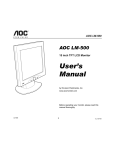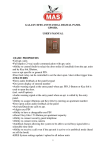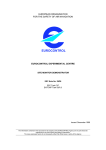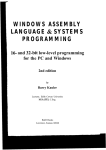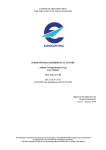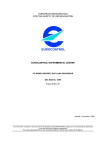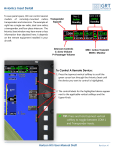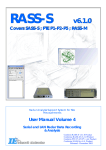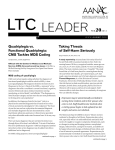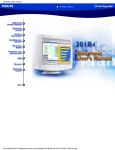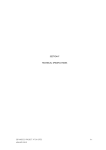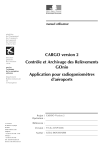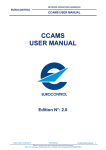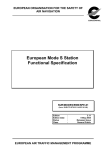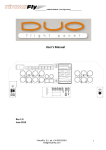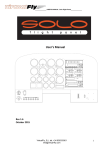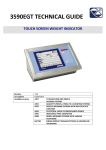Download Test Communication Managment Unit TCMU
Transcript
EUROPEAN ORGANISATION FOR THE SAFETY OF AIR NAVIGATION EUROCONTROL EUROCONTROL EXPERIMENTAL CENTRE Test Communication Management Unit EEC Note No. 23/96 EEC Task C07 EATCHIP Task FCO.ET3.ST08 Issued: September 1996 The information contained in this document is the property of the EUROCONTROL Agency and no part should be reproduced in any form without the Agency’s permission. The views expressed herein do not necessarily reflect the official views or policy of the Agency. REPORT DOCUMENTATION PAGE Reference: EEC Note No. 23/96 Security Classification: Unclassified Originator: EEC - COM (Communication) Originator (Corporate Author) Name/Location: EUROCONTROL Experimental Centre B.P.15 F - 91222 Brétigny-sur-Orge CEDEX FRANCE Telephone : +33 1 69 88 75 00 Sponsor: EATCHIP Development Directorate Sponsor (Contract Authority) Name/Location: EUROCONTROL Agency Rue de la Fusée, 96 B -1130 BRUXELLES Telephone : +32 2 729 9011 TITLE: Test Communication Management Unit Authors Date Pages Figures Photos Appendix References 09/96 iv+16 4 2 1 4 Hans P. ENGLMEIER João M. M. MARTINS EATCHIP Task Specification FCO.ET3.ST08 EEC Task No. Task. No Sponsor Period C07 EAS2 4/96 to 5/96 Distribution Statement: (a) Controlled by: Head of COM (b) Special Limitations: None (c) Copy to NTIS: YES / NO Descriptors (keywords): AT58 - Mode-S Subnetwork - Aircraft Equipment Simulation - ARINC Protocols -Test Communication Management Unit - HP UX Environment - Remote Installation - Advanced ARINC Card - HP UX C Abstract: This report describes the software architectural design and user manual of the Test Communication Management Unit. This document has been collated by mechanical means. Should there be missing pages, please report to: EUROCONTROL Experimental Centre Publications Office B.P. 15 91222 - BRETIGNY-SUR-ORGE CEDEX France EEC Note No. 23/96 EEC Task No. C07 EATCHIP Task No. FCO.ET3.ST08 Issued : September 1996 Test Communication Management Unit by Hans Peter ENGLMEIER and João Manuel MATEUS MARTINS EUROCONTROL Experimental Centre Summary This report describes the software architectural design and user manual of the Test Communication Management Unit Test Communication Management iii CONTENTS 1. ACRONYMS AND ABBREVIATIONS DEFINITIONS ..........................................................................1 2. PURPOSE AND SCOPE ............................................................................................................................2 3. MAJOR FEATURES OF THE TEST COMMUNICATION MANAGEMENT UNIT ..........................2 4. GENERAL OVERVIEW ...........................................................................................................................3 5. MESSAGES FORMAT ..............................................................................................................................4 5.1. INTRODUCTION ...........................................................................................................................................4 5.2. MSP MESSAGE FORMAT .............................................................................................................................4 5.3. BROADCAST MESSAGE FORMAT ..................................................................................................................4 5.4. GICB MESSAGE FORMAT............................................................................................................................4 6. TCMU SOFTWARE ARCHITECTURAL DESIGN ................................................................................5 7. TEST COMMUNICATION MANAGEMENT UNIT USER MANUAL .................................................7 7.1. INTRODUCTION ...........................................................................................................................................7 7.2. INSTALLING THE TEST COMMUNICATION MANAGEMENT UNIT ......................................................................7 7.3. RUNNING THE TEST COMMUNICATION MANAGEMENT UNIT..........................................................................8 7.4. TEST COMMUNICATION MANAGEMENT UNIT OPERATING INSTRUCTIONS ......................................................9 7.4.1. GICB Editor .......................................................................................................................................9 7.4.2. Main User Interface..........................................................................................................................13 7.4.2.1. Broadcast Messages.......................................................................................................................13 7.4.2.2. MSP Messages ...............................................................................................................................13 7.4.2.2.1. Load Message or File..................................................................................................................13 7.4.2.2.2. Load File ...................................................................................................................................13 7.4.2.2.3. Load Message .............................................................................................................................13 7.4.2.2.4. Receive File ................................................................................................................................14 7.4.2.2.5. Quit TCMU.................................................................................................................................14 7.4.3. Final Considerations ........................................................................................................................14 8. TEST PROCEDURES AND FUTURE DEVELOPMENTS ...................................................................15 9. REFERENCES .........................................................................................................................................16 APPENDIX 1 PHOTO N° 1 PHOTO N° 2 Test Communication Management iv 1. Acronyms and Abbreviations Definitions AAC Advanced ARINC Card ADLP Aircraft Data Link Processor Unit ADS Automatic Dependent Surveillance ATN Aeronautical Telecommunication Network BDS Binary Data Store. Register number with 56 bit in the Mode S transponder. ELM Extended Length Message GICB Ground Initiated Comm-B Messages GPFT General Purpose File Transfer Protocol ICAO International Civil Aviation Organisation LDU Link Data Unit MA Comm-A message, 56 bit field MC Comm-C message, 80 bit field MOPS Minimal Operation Requirements Document MSP Mode S Specific Protocol SLM Short Length Message STNA Service Technique de la Navigation Aérienne TRT Télécommunications Radio-électriques et Téléphoniques TUB Technische Universität Braunschweig XPDR Mode S Transponder Test Communication Management 1 2. Purpose and Scope The purpose of this document is to provide an overall description of the software architectural design and user manual of the Test Communication Management Unit developed at the EUROCONTROL Experimental Centre. 3. Major Features of the Test Communication Management Unit Test Communication Managment Unit TCMU GICB EDITING MESSAGES EDITING GICB GENERATION DOWNLINK MESSAGES GENERATION DATA LINK MONITORING ARINC 429-14 GENERAL PURPOSE FILE TRANSFER GENERATION Figure no. 1 - Major features of the Test Communication Management Unit Test Communication Management 2 The Test Communication Management Unit is a software device Installed in a HPUX workstation and using an Advanced ARINC Card version 2 (EEC Note No. 17/94). This software enables the user to generate or monitor Mode S data link messages. The transmission of MSP, Broadcast and GICB messages, is supported by the AAC using an ARINC 429-14 GPFT Protocol. 4. General Overview ARINC 429-14 caring MSP, Broadcast and GICB’s Messages Mode S Transponder ARINC 718 Protocol TCMU Simulation Mode S Specific Services Entity Aircraft Data Link Processor ARINC 429-14 caring X25 packets ISO 8208 Entity Figure no. 2 - General overview of an airborne ADLP environment The figure shown above gives a general overview of the airborne Aircraft Data Link Processor environment. With the evolution of the new generation of Mode S equipment and having in mind the implementation of the future ATN, the need to have low cost tools able to evaluate the harmonisation of communication protocols between different types of AVIONICS equipment set, became apparent. The software feature presented in this note, the TCMU, is able to simulate a Mode S Specific Services entity as shown above in an experimental and test environment. Installed in HP-UX workstation connected to a standard network environment, this software offers the possibility of being remote controlled and accessed from anywhere. Using the ARINC 429-14 GPFT which corresponds to the ISO level 2 link layer, this software is open to the encapsulation of any communication protocol running over it. An immediate application of these principles and behaviours is the transport of MSP, Broadcast and GICB messages. Test Communication Management 3 The format of these messages is defined in the next chapter. 5. 5.1. Messages Format Introduction The format defined below correspond to the one used by the Rockwell & Collins ADLP. 5.2. MSP Message Format The format of the MSP message transmitted between the ADLP and the TCMU for uplink and downlink shall be as follows: 5.3. Byte 1 ⇒ MSP Message Type, always 13 (hexadecimal). “ 2 ⇒ MSP Channel Number, defined in the ADLP MOPS document, table 2-6. “ 3 ⇒ MSP Length, number of MSP data bytes that follows. “ 4..n ⇒ MSP Data. Broadcast Message Format The format for a Broadcast message transmitted between the ADLP and the TCMU shall be as follows: Byte 1 5.4. ⇒ Broadcast Message Type, always 11 (hexadecimal). ⇒ Broadcast Identifier, defined in the ADLP MOPS document, table 2-7. “ 2 “ 3..8 ⇒ Broadcast Data. GICB Message Format The format for a GICB message transmitted to the ADLP shall be as follows: Byte 1 ⇒ GICB Message Type, always 10 (hexadecimal). ⇒ GICB Register Number, defined in the ADLP MOPS document, table 2-5. “ 2 “ 3..9 ⇒ GICB Data. An example of a GICB message for the register 40 can be found in appendix No. 1. Test Communication Management 4 6. TCMU Software Architectural Design 1- Uplink Monitor 3- Downlink Monitor 2- User Interface F1 F3 7- GICB Editor F2 4- Uplink Driver 5- Main Process F5 F6 F4 6- Downlink Driver F7 8- GICB Generator F8 9- AAC Interface F9 High Level TCMU part N0 Test Communication Management Unit installed in a HP-UX workstation 10- AAC Driver N1 11- AAC Firmware Advanced Arinc Card version 2 board A0 A1 ARINC 718 Bus Figure no. 3 - TCMU software architectural design Test Communication Management 5 Notes : 1. 2. 3. F1 to F9 are System V IPC facilities, shared memory and semaphores N0 and N1 are HP-UX kernel data transfer blocks A0 and A1 are ARINC channels As shown in figure No. 2, the TCMU is basically a data link processor. This software device can be split in three parts, the high level running in the HP-UX workstation, the HP-UX driver to access the AAC and finally, the low level software running in the card, the firmware. The high level part performs the following tasks: AAC driver interface, user interfacing, MSP, GICBs and Broadcast messages generation and finally data link monitoring. This part was written in HP-UX C programming language. Since the application is running in a HP-UX operating system it became necessary to implement a HP-UX driver to access the card. This driver developed by Hewlett-Packard France can be configured accordingly with the chosen AAC interrupt level or memory address. The configuration manual of this driver is not included in this document but can be supplied by EUROCONTROL. Finally, the low level software running in the card, the firmware, implementing the high speed ARINC Williamsbourg 429-14 Bit Oriented Protocol. The firmware architectural design and functional description are not included in this document but can be supplied by EUROCONTROL. Test Communication Management 6 7. Test Communication Management Unit User Manual 7.1. Introduction The purpose of this chapter is to give a general overview of how a user can install and implement this software package and, at the same time, to describe how to use all the TCMU software facilities. 7.2. Installing the Test Communication Management Unit The TCMU software is archived in the file “tcmu.tar”. In the subdirectory TCMU use the command “tar -xvf tcmu.tar” to extract all related files. In the subdirectory TCMU /tcmu.bin execute the file “make0” to compile the source files which are located in the subdirectory TCMU/tcmu.src. After successful compiling the following executable files should be found. “tcmumain" Main process *“tcmuaac" AAC interface *“tcmup" Uplink driver. “tcmudown" Downlink driver *“tcmudownmon" Downlink monitor *“tcmupmon" Uplink monitor “tcmuser" User interface. “tcmu" File script to start running the TCMU *“tcmugigen" GICB generation file “tcmugiedit" GICB editor “gicb.dat” Default file with AVIONICS data “sem.ftok.tcmu” IPC semaphores facilities reference file “shm.ftok.tcmu” IPC shared memory facilities reference file . “gpftcmu.exe" AAC firmware * Note : All screen output messages are recorded in a file with extension “.rec”. Test Communication Management 7 The complete list of files necessary to run the TCMU should also include the HP-UX driver necessary to establish the connection between the AAC firmware and this software application. 7.3. Running the Test Communication Management Unit To start running the user should type "tcmu". This script file before activating the 9 processes mentioned below asks the name of the GICB file used. If nothing is written, after having pressed <ENTER> key, the file “gicb.dat” is read by default, see Photo1. Each of the 9 processes activated are running in a single « hpterm » visual window, see Photo 2. TCMU_DOWNLINK_DRIVER ⇒ “tcmudown” TCMU_UPLINK_DRIVER ⇒ “tcmup” TCMU_DOWNLINK_MONITOR ⇒ “tcmudownmon” TCMU_UPLINK_MONITOR ⇒ “tcmupmon” TCMU_AAC_INTERFACE ⇒ “tcmuaac” TCMU_USER_INTERFACE ⇒ “tcmuser” TCMU_MAIN_PROCESS ⇒ “tcmumain” TCMU_GICB_GENERATOR ⇒ “tcmugigen” TCMU_GICB_EDITOR ⇒ “tcmugiedit” Use the mouse to select the correspondent « hpterm » window. How to operate with all processes will be described in the next chapter. Test Communication Management 8 7.4. Test Communication Management Unit Operating Instructions 7.4.1. GICB Editor The GICB editor is an on line editor of simulated AVIONICS data. Data can be introduced having as parameters the BDS number, the resolution and the minimum and maximum value accepted. BDS 5 DATA RANGE RESOLUTION Airborne Format Surveillance Status Turn Indicator Bit Barometric Altitude 0, 7..14 0..3 0..1 50,175 ft ------------------------------25 ft 0..1 + 90° + 180° -----------0.0007 ° 0.0014 ° 0, 5,6 0..128 + 180° 50,175 ft --------------------2.816 ° 25 ft 0..1 + 90° + 180° -----------0.0007 ° 0.0014 ° + 180° 4g + 180° 131,072 ft 0.18° 0.001 g 0.044° 8 ft 4.096 Mach 1,024 Kt + 180° + 180° 0.001 Mach 0.5 Kt 0.044° 0.044° Time Bit Latitude Longitude 6 Type Movement MOV_SPM Track Barometric Altitude Time Bit Latitude Longitude 40 Flight Path Angle Flight Path Acceleration Corrected Angle of Attack Barometric Correction Altitude 50 Mach Number Computed Air Speed Track Angle True Track Angle Magnetic Test Communication Management 9 BDS DATA RANGE RESOLUTION + 180° 2,048 Kt + 16,384 ft/min + 512° 0.044° 0.5 Kt 64 ft/min 0.5° 65,536 ft + 180° 270 271 16 ft 0.8° Binary Input Binary Input 60 Track Angle Magnetic Ground Speed Altitude Rate Static Air Temperature 70 Selected Altitude Range Selected Heading Status Word 1 Status Word 2 80 Selected Airspeed Selected Altitude Rate Selected Altitude Status Word 1 512 Kt 16,384 ft/min 45,536 ft Label 270 0.25 Kt 16 ft/min 16 ft Binary Input 90 Selected Mach Number Selected Altitude Rate Selected Altitude Status Word 2 4.096 Mach 16,834 ft/min 65,536 ft Label 271 0.002 Mach 16 ft/min 16 ft Binary Input AO Cross Track Error Vertical Deviation Acceleration 128 nm 2,048 ft +1g 0.004 nm 1 ft 0.016 g BO Computer Airspeed True Airspeed Mach Heading (magnetic) 1,024 Kt 2,048 Kt 4.096 Mach + 180° 0.25 Kt 0.5 Kt 0.00025 Mach 0,18° 21 Magnetic Heading True Air Speed Static Air Temperature Normal Acceleration + 180° 2,048 Kt + 512°C +1g 0.18° 0.5 Kt 0.5° C 0.016 g 31 Bearing to Waypoint Time to Go Distance to go + 180° 399.9 min 399.9 nm 0.18° 0.1 min 0.1 nm Test Communication Management 10 BDS DATA RANGE RESOLUTION 3 characters 3 characters + 180° ISO 5 ISO 5 0.18° 0.00035° 0.0007° 8 ft 41 Active Waypoint 1 Active Waypoint 2 Desired Track 51 Latitude Longitude Altitude + 90° + 180° 131,072 ft 61 G.M.T. Flight Number HHMMSS xxxx 71 Roll Angle Altitude Rate Wind Speed Wind Angle + 90° + 8,192 ft/min 256 Kt + 180° 0,35° 128 ft/min 1 Kt 0.703° CO Radio Height Average Static Pressure Altitude 8,192 ft 1,024 mb 131,072 ft 1 ft 0.25 mb 1 ft 24 Centre of Gravity Gross Weight 99.9 % 131,072 lbs 0.1 % 160 lbs Test Communication Management 11 BDS DATA RANGE RESOLUTION 17 N1 Actual Engine # 1 Fuel Flow Engine # 1 Total Air Temperature Static Air Temperature 256 % rpm 32,768 lb/hr ± 512°C ± 512°C 0.13 % rpm 8 lb/hr 0.5°C 0.5°C 27 N1 Actual Engine # 2 Fuel Flow Engine # 2 Total Air Temperature Static Air Temperature 256 % rpm 32,768 lb/hr ± 512°C ± 512°C 0.13 % rpm 8 lb/hr 0.5°C 0.5°C 37 N1 Actual Engine # 3 Fuel Flow Engine # 3 Total Air Temperature Static Air Temperature 256 % rpm 32,768 lb/hr ± 512°C ± 512°C 0.13 % rpm 8 lb/hr 0.5°C 0.5°C 47 N1 Actual Engine # 4 Fuel Flow Engine # 4 Total Air Temperature Static Air Temperature 256 % rpm 32,768 lb/hr ± 512°C ± 512°C 0.13 % rpm 8 lb/hr 0.5°C 0.5°C 1A Aircraft Identification Aircraft Identification Aircraft Identification 2 char. ISO5 2 char. ISO5 2 char. ISO5 Label 233 Label 234 Label 235 1B Aircraft Identification Aircraft identification 2 char. ISO5 2 char. ISO5 Label 236 Label 237 Test Communication Management 12 7.4.2. Main User Interface This process allows the user to terminate a TCMU session and to edit or send downlink MSP or Broadcast messages. 7.4.2.1. Broadcast Messages To chose this option type <0>. Confirm it by typing <y>, <Y> or <ENTER>. Type <Y>, <y> or <ENTER> to confirm your edition and <N> or <n> to cancel it. For the complete editing of your Broadcast message fill the following displayed table. Use decimal characters and type <ENTER> to finish. . BROADCAST MESSAGE BROADCAST IDENTIFIER 7.4.2.2. MSP Messages 7.4.2.2.1. Load Message or File To chose this option type <1>. Confirm it by typing <y>, <Y> or <ENTER>. 7.4.2.2.2. Load File To chose this option type <1>. Confirm it by typing <y>, <Y> or <ENTER>. Type your file name and type <ENTER> to finish. Confirm it by typing <y>, <Y> or <ENTER>. If your file does not exist the following message will be printed in the screen: “ Your file does not exist. ” To complete your edition of fill the following displayed table. Use decimal numbers and type <ENTER> to finish. MSP PACKET MSP CHANNEL NUMBER Type <Y>, <y> or <ENTER> to confirm your edition and <N> or <n> to cancel it. 7.4.2.2.3. Load Message To chose this option type <2>. Confirm it by typing <y>, <Y> or <ENTER>. Test Communication Management 13 Type your message with a maximum of 644 characters and type <ENTER> to finish. 644 Characters corresponds to a single LDU. Type <Y>, <y> or <ENTER> to confirm your edition and <N> or <n> to cancel it. For the complete editing of your MSP message fill the following displayed table. Use decimal numbers and type <ENTER> to finish. MSP PACKET MSP CHANNEL NUMBER Type <Y>, <y> or <ENTER> to confirm your edition and <N> or <n> to cancel it. 7.4.2.2.4. Receive File To chose this option type <2>. Confirm it by typing <y>, <Y> or <ENTER>. Type your file name and type <ENTER> to finish. Confirm it by typing <y>, <Y> or <ENTER>. If your file already exist the following message will be printed in the screen: “ Your file already exist, do you want to overwrite” If you want to overwrite type <y>, <Y> or <ENTER>, otherwise type <n> or <N>. To stop recording type <ENTER>. 7.4.2.2.5. Quit TCMU To quit and close all processes type <q> or <Q>. Confirm it by typing <y>, <Y> or <ENTER>. To cancel it type <N> or <n> . 7.4.3. Final Considerations All the other processes do not require any user operation. Test Communication Management 14 8. Test Procedures and Future Developments Rockwell & Collins Aircraft Mode S Equipment Set GPS Antenna GPS RF Datalink Mode S Antenna GPS CONTROL BOX Mode S RF Datalink TCMU XPDR ADLP ARINC 429-14 GPFT Test Bench IFR or Thompson & TRT Uplink Mode S RF Interrogations Figure no. 4 TCMU Simulation environment With the purpose of doing an evaluation of the Rockwell & Collins Mode S aircraft equipment set, several tests were made using the simulation environment shown above. This equipment set is composed of a Mode S transponder (XPDR), a Global Positioning System (GPS), an Aircraft Data Link Processor (ADLP) and a control box. The major interests of these tests were to establish a data link able to transport GICB, MSP and broadcast messages for uplink and downlink using ARINC 429-14 GPFT between the TCMU and this equipment set. Test Communication Management 15 9. References EEC Note No. 17/94 - ADVANCED PC ARINC CARD - VERSION 2 by H.P. ENGLMEIER ARINC Document - MARK 3 Air Traffic Control Transponder (ATCRBS / Mode S) ARINC Characteristic 718-4, 15.12.1989 ICAO Aeronautical Telecommunications (Annex 10) Test Communication Management 16 Appendix 1 1. GICB Message for the register number 40. Bit 1 Status bit of flight path angle, label 322, range + - 180°, 10 bit, resolution 0,18° . Bit 2 Bit 3..12 Sign bit Data = 190° Bit N° 1 12 1 1 1 1 1 0 1 1 0 0 0 0 Bit 13 Status bit of flight path acceleration, label 323, range 4 g, 12 bit, resolution 0.001g Bit 14 Bit 15..26 Sign bit , always 0 Data = 0,016 g Bit N° 13 26 1 0 0 0 0 0 0 0 0 1 0 0 0 0 Bit 27 Status bit of corrected angle of attack, label 241, range + - 180°, 12 bit, resolution 0,044° Bit 28 Bit 29..40 Sign bit Data = 10° Bit N° 27 40 1 0 0 0 0 0 1 1 1 0 0 1 0 0 Bit 41 Status bit of barometric corrected altitude, label 204, range 131072 ft, 14 bit, resolution 8 ft Bit 42 Bit 43..56 Sign bit, always 0 Data = 34000 ft Bit N° 41 56 1 0 0 1 0 0 0 0 1 0 0 1 1 0 1 0 Test Communication Management 1 The GICB message will be : 10 GICB message type 40 Register number c3 GICB data = c3980420e4909a 98 04 20 e4 90 9a All numbers are in hexadecimal notation. Test Communication Management 2


























